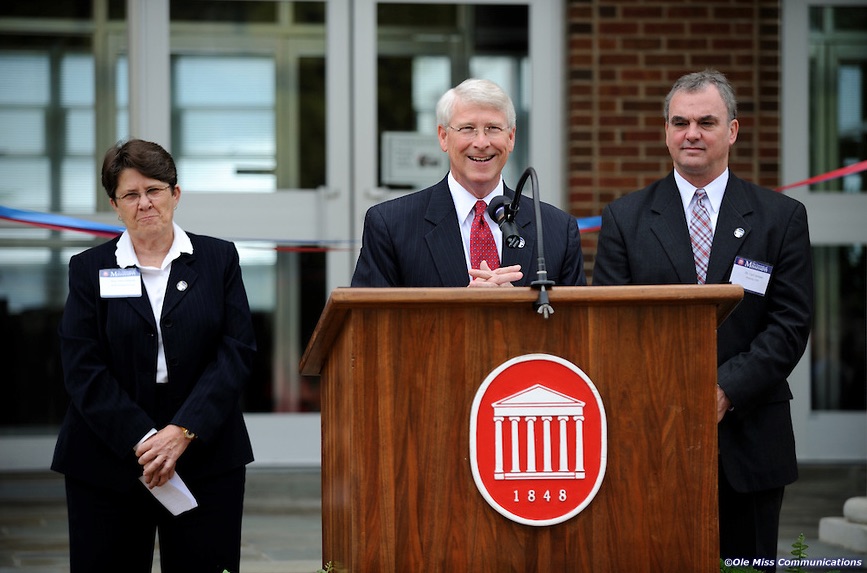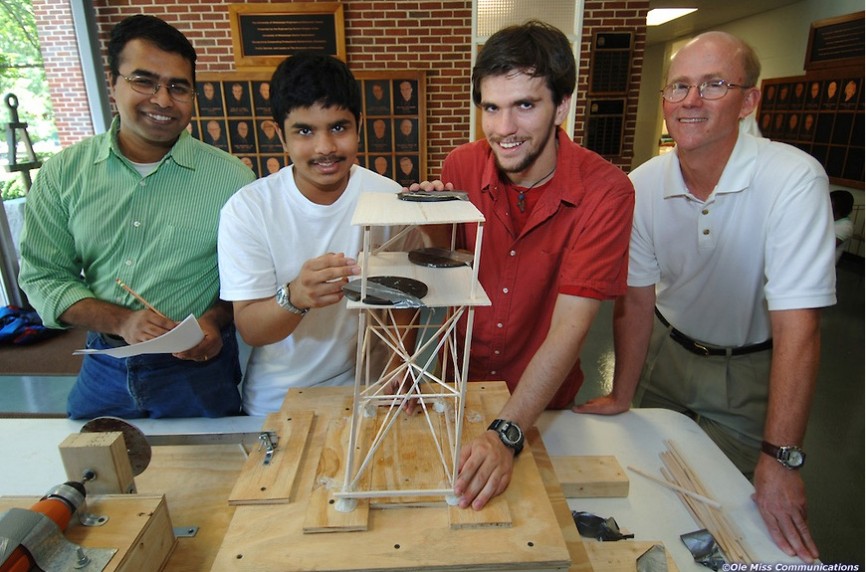Defense and Homeland Security
Overview
A long-time home to excellence in naval shipbuilding, a number of military bases, and defense contractors, Mississippi continues to grow its homeland security and defense-related capacity. Approximately 55 defense-related manufacturers are located in Mississippi. Combined, they employ 21,000 people in the state (MS Power Economic Development). As a source of R&D to this industry, the University of Mississippi contributes to the state’s strength particularly in the application areas of infrastructure, disaster response, and composite materials.
Protecting Against Natural Hazards and Terrorist Threats:
Nano Infrastructure Research Group (NIRG) focuses on the utilization of nano particles such as carbon nanotube, nanowire, nanoclay, graphite and glass platelets, and flyash, for reinforcing polymers and concrete to make nanocomposites. These composites are applied to the protection of infrastructures (buildings, bridges, tunnels, pipelines, ports, levees and floodwalls, power and communication transmission facilities) against all kinds of natural hazards and terrorist threats, including blast, impact, earthquakes, hurricanes, fire, corrosion, and fatigue collapse. These materials are also used in defense applications such as protecting navy ships against blast, for fire protection, and shielding against electromagnetic detection (stealth).
Applying Composite Materials to Homeland Security and Civil Engineering:
Composite Structures and Nano Engineering Research Group (CSNERG) fosters interdisciplinary research and education in advanced composite materials and structures, with an emphasis on nano-composites and their application in infrastructure, mechanical, electrical, chemical and other engineering sectors. As a multi-disciplinary group, CSNERG strengths include blast survivability and homeland security; composite/hybrid materials and structures; mechanics from nano, micro, on up to macro scales; impact and crash worthiness; electric power and telecommunications; chemical and biological systems; and simulations/modeling.
Acoustics Research & Expertise Applied to Natural Hazards and Health Monitoring:
National Center for Physical Acoustics (NCPA) specializes in basic and applied research in the area of physical acoustics. The atmospheric acoustics group has developed acoustic detection of various arms and ordnances and also works on natural hazard projects for NOAA. The aero-acoustics team is looking at noise reduction in aircraft, ways to more efficiently mix fuel, and better designs for cargo and weapons bays. NCPA also has expertise in sensors and methodology for structural health monitoring in extreme work environments such as air frames, jet engines, natural gas turbines, and nuclear reactor cores. NCPA collaborates with a number of government and industry partners such as Pratt & Whitney, Northrup Grumman, Radiance Technologies, Miltec, and the U.S. Army.
Software Helping Emergency Personnel with Evacuation Planning:
National Center for Computational Hydroscience and Engineering (NCCHE) created software that is helping emergency managers around the nation in making informed decisions on evacuation plans in real time and is being used by agencies such as the Headquarters and District offices of the U.S. Army Corps of Engineers, including the Vicksburg District and the USACE Engineer Research and Development Center, as well as the Mississippi Department of Environmental Quality, and the Department of Homeland Security Dams Sector Branch.
Training Next Generation of Intelligence Community:
Center for Intelligence and Security Studies (CISS) trains students for careers in intelligence analysis and provides educational and scholarly resources to the national Intelligence Community (IC). In addition to offering a minor, CISS conducts outreach efforts by sponsoring a consortium of organizations with an interest in analytical matters and national security. In 2012, the Director of National Intelligence designated the CISS as an Intelligence Community Center of Academic Excellence.
Helping Communities Respond and Recover from Disasters:
Clinical Disaster Research Center (CDRC) integrates service, training, and research in disaster mental health. The Center develops evidence-based disaster preparedness, mitigation, and response practices to meet the needs of the University, local community, and region. The CDRC strives to better understand the experiences of those affected by disasters and how they cope with these events. With rigorous, systematic research as a foundation, and with expertise in clinical, community, multicultural, and positive psychology, the CDRC works to understand how concepts like resilience, self-efficacy, and perceived meaning foster disaster recovery and posttraumatic growth.
Legal Support for Coastal Communities Mitigating Hazards:
National Sea Grant Law Center encourages a well-informed constituency by providing legal information and analysis to the Sea Grant Community, policy-makers, and the general public through a variety of products and services. Since 2002, the Center has provided legal research, outreach, and education to support the development of resilient coastal communities that sustain diverse and vibrant economies, effectively respond to and mitigate hazards, and function within the limits of their ecosystem.
Safeguarding Against Physical and Economic Losses From Earthquakes:
Center for Community Earthquake Preparedness (CCEP) performs structural, geotechnical, and geological research projects and implements this research through data collection, design, construction, and field investigation activities for the benefit of targeted communities with significant seismic hazards. Center investigators work together with and directly assist where possible the emergency management personnel, community planners, and business leaders in developing and conducting projects that will directly benefit the community, safeguarding both the local citizens and their livelihoods from the physical and economic losses sustained during earthquake events. Center projects focus on quantifying local seismic hazards, site dynamic response properties, and structural response characteristics for critical facilities in the community, and developing and implementing cost-effective mitigation strategies.



